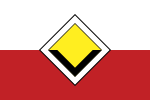Viking Line
Viking Line Abp is a Finnish shipping company that operates a fleet of ferries and cruiseferries between Finland, the Åland Islands, Sweden and Estonia.
Viking Line's history can be traced back to 1959, when a group of sea- and businessmen from the Åland Islands province in Finland formed Rederi Ab Vikinglinjen, purchased a steam-powered car-ferry SS Dinard from the UK, renamed her SS Viking and began service on the route Korpo (Finland)–Mariehamn (Åland)–Gräddö (Sweden).
[2][3]: 18–20 In the same year the Gotland-based Rederi AB Slite began a service between Simpnäs (Sweden) and Mariehamn.
[3]: 18–20 Soon the three companies, all competing for passengers between Åland Islands and Sweden, realised that they in the long run all stood to lose from mutual competition.
[3]: 18–20 The red hull livery was adopted from Slite's Ålandspilen service[3]: 22–23 [4] (to which it had been taken from the colour of the chairman's wife's lipstick![5]).
During the 1970s Viking expanded greatly and overtook Silja Line as the largest shipping consortium on the Northern Baltic Sea.
[3]: 40–43 These so-called Papenburg sisters can be considered to be one of the most successful ships designs of all times[citation needed] (the shipyard built three additional sisters of the original design for Transbordadores for ship services in Mexico: Coromuel,[7] Puerto Vallarta[8] and Azteca[9]).
The next year Slite took delivery of Mariella's sister MS Olympia and thus forced Sally out of Helsinki–Stockholm traffic completely.
Since the shipyard owned the unfinished ship, this led to an increased cost for the Kalypso[12]—about 200 million SEK more than had been originally envisaged.
[citation needed] In the end, despite the financial problems, by 1990 Viking Line had the largest and newest cruiseferry fleet in the world.
In 1989[citation needed] Slite started planning MS Europa, which was to be the jewel in the company's crown, the largest and most luxurious cruiseferry in the world.
Eventually the ship ended up in Silja Line's fleet and Slite was forced to declare bankruptcy in 1993.
Between 1994 and 1996 the company operated a fast ferry service from Helsinki to Tallinn during the summers on chartered catamaran ships.
[25] In a seminar held in January 2010, Backman stated that Viking Line were negotiating with nine different shipyards about the possibility of constructing a pair of 60,000 GT ships to replace Amorella and Isabella on the Turku–Stockholm service.
[26][27] The possibility of using liquefied natural gas engines and other emission-reducing technologies were reportedly researched,[28][29] while according to Mikael Backman the ships would include various features akin to those found onboard cruise ships such as Royal Caribbean International's MS Oasis of the Seas.
[30] In October 2010 Viking Line signed a letter of intent with STX Turku for a 57,000 GT cruiseferry for the Turku–Stockholm route.












